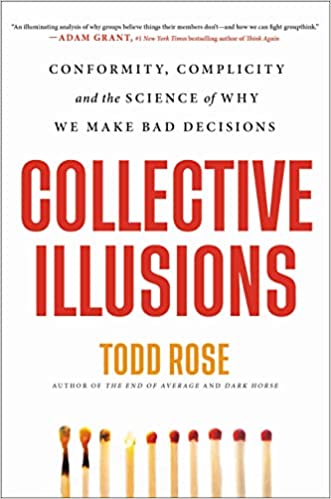You have /5 articles left.
Sign up for a free account or log in.
 Collective Illusions: Conformity, Complicity and the Science of Why We Make Bad Decisions by Todd Rose
Collective Illusions: Conformity, Complicity and the Science of Why We Make Bad Decisions by Todd Rose
Published in February 2022
I’ve been a fan of development psychologist Todd Rose’s writing since reading his 2016 book, The End of Average.
Since writing that book, Rose has moved on from his faculty gig at Harvard to co-found Populace, a think tank “dedicated to building a world where all people have the chance to live fulfilling lives in a thriving society.”
In Collective Illusions, Rose takes on why individuals so often pursue illogical goals and participate in socially destructive behaviors. The reason is that our brains are hardwired for social conformity. To maintain alignment with the social networks that we are embedded in, we will often publicly go along with behaviors and espouse ideas that we privately disagree with.
Groupthink and mindless conformity have always been with us. Social media and politically motivated news contribute to spreading collective illusions. When broadcast widely or repeatedly posted (often by bots), extreme viewpoints can start to seem like majority opinions, even when those views are in reality held by a small number of individuals.
The way to avoid the spread of collective illusions, according to Rose, is for all of us to work to align our public behaviors with our private beliefs. We should not assume that “everyone” thinks in a certain way, as true preferences are often hidden.
One example Rose gives is in elections. Voting behaviors tend to conform with beliefs of who is most likely to be elected rather than the candidate that voters genuinely prefer. This bias tends to hurt women and nonwhite candidates, as there is a collective illusion that white men are more “electable.”
The framing of collective illusions provides a helpful lens through which to think about how aspects of higher education persist, despite the private doubts that many in academia may hold.
One example that comes to mind is grading. How many of us continue to believe that summative grading is an effective tool to promote student learning? Given all that we know about the ineffectiveness of high-stakes exams as measures of long-term retention and as predictors of future success, why is it that high-stakes exams and final course grades are still the norm?
The same questions can be asked about student teaching evaluations. We know they are biased, unreliable and ineffective measures of teaching quality, and yet we persist in utilizing them for decisions related to promotion and tenure.
On the academic staff side, we all endure the performative theater of the annual performance review. We participate in this process, both giving and receiving reviews, even though we understand that the exercise is primarily designed to provide documentation to help institutions move out chronic underperformers and does little to build motivation or actionable guidance for most academic staff.
Academics are likely as guilty as everyone else in conforming to what we understand to be shared norms of thinking and behavior, at least within the context of our colleges and universities.
Reading and discussing Collective Illusions might at least provide us with a safe space to have campus conversations about what we believe about how things are done at our institutions and across higher education.
We might find to our surprise that some long-standing practices in academia have fewer defenders than we imagine.
What are you reading?




